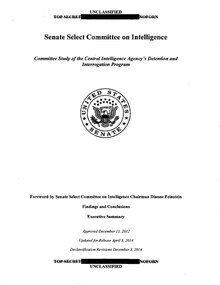Senate Intelligence Committee report on CIA torture: Difference between revisions
→Key findings: You can't cut paste, unfortunately you have to re-write each of those and cite the report, or one of the other new websites that currently has that list cut-pasted on their website |
→Financial aspects: deadlink removed |
||
| Line 28: | Line 28: | ||
==Financial aspects== |
==Financial aspects== |
||
The report cost $40 million to assemble.<ref name=GuardDec0914/> |
The report cost $40 million to assemble.<ref name=GuardDec0914/> |
||
Two psychologists who helped the CIA create the torture techniques earned over {{USD}}81 million as contractors.<ref>{{cite web|title=17 Disgraceful Facts Buried In The Senate’s 600 Page Torture Report|url=http://thinkprogress.org/world/2014/12/09/3601312/17-disgraceful-facts-contained-in-the-torture-report/|publisher=ThinkProgress|accessdate=9 December 2014}}</ref> |
|||
==See also== |
==See also== |
||
Revision as of 21:03, 9 December 2014

The Senate Select Committee on Intelligence Study of the Central Intelligence Agency's Detention and Interrogation Program, commonly known as the CIA Torture Report, is a 6,000 page report compiled by the United States Senate Select Committee on Intelligence on the enhanced interrogation techniques (a euphemism for torture) on detainees practiced by the Central Intelligence Agency (CIA) following the September 11 attacks in 2001. The full report has not been published, but the committee voted in April 2014 to release the recommendations, executive summary, and findings of the report, which may be between 480 and 700 pages in size.[1][2] The report is said to be critical of the CIA's policies on torture during the War on Terror in the immediate years after the September 11 attacks.[3][4] The report is the result of several years of research and has been compiled by the Democratic members of the committee; another report is expected to be published by the committee's Republican members.[5]
The report took four years to compile and cost $40 million.[6] Feinstein has said that the report was conducted after CIA official Jose Rodriguez destroyed almost 100 video recorded interrogations and the committee believed that he was covering up illegal activities by the CIA. The committee had initially been told that Rodriguez was not engaging in 'destruction of evidence' by officials.[2]
Rodriguez preemptively criticized the report in an op-ed for The Washington Post on December 5, 2014.[7]
The 525-page unclassified report was released on December 9, 2014 after a presentation by Dianne Feinstein in the Senate floor.[8]
Findings
- Torture of prisoners led to serious mental harm (eg. dementia, paranoia, insomnia, and attempts at self-harm (including suicide)[9]
- The CIA had force feed prisoners both orally and anally in order to establish “total control over the detainee.”[9] The Rome Statute defines defines the "rape" as:"The perpetrator invaded the ... anal or genital opening of the victim with any object..."[10]
- The CIA's directors (George J. Tenet, Porter J. Goss and Michael V. Hayden) lied to members of the U.S. Congress, the White House and the Director of National Intelligence about the program’s effectiveness and the number of prisoners that the CIA held.[11]
- The CIA deliberated planted false stories with members of the media and claimed that the stories had been leaked (although CIA officials never investigated the leaks because they had themselves planned to leak the false and misleading information).[11]
- The CIA had used waterboarding at locations it previously had claimed it had not (eg. at The Salt Pit).[11]
- Threats were made against the children or family members of prisoners.[12]
- The CIA killed at least one prisoner during interrogation.[13]
- Some CIA personnel found the torture revolting and asked to be transferred from such facilities. Some also questioned whether such activities could continue and were told that the senior officials in the CIA had approved these techniques.[11]
- At least 26 of the 119 (21% or just over 1 in 5) prisoners held by the CIA were later found to be innocent, many having also experienced torture.[14]
- One mentally challenged man was held by the CIA in order to obtain information from one of his family members.[14]
- The CIA kept incomplete records of who they kept prisoner.[14]
- Two former intelligency soures were jailed and tortured.[14]
- Two people identified by a prisoner as threats were jailed and tortured.[14]
Financial aspects
The report cost $40 million to assemble.[6]
See also
References
- ^ Lauren Hodges (8 December 2014). "Congress Clashes Over Release of CIA Torture Report". NPR News. Retrieved 8 December 2014.
- ^ a b Spencer Ackerman (5 August 2014). "Top senator rejects CIA torture report redactions ahead of public release". The Guardian. Retrieved 8 December 2014.
- ^ Peter Baker (7 December 2014). "Bush and C.I.A. Ex-Officials Rebut Torture Report". New York Times. Retrieved 8 December 2014.
- ^ Spencer Ackerman, "CIA torture report: agency braces for impact of inquiry as release nears", The Guardian, December 9, 2014.
- ^ "CIA torture report: US raises security ahead of release". BBC News Online. 9 December 2014. Retrieved 9 December 2014.
- ^ a b Spencer Ackerman (9 December 2014). "CIA's brutal and ineffective use of torture revealed in landmark report". The Guardian. Retrieved 9 December 2014.
- ^ Jose Rodriguez (intelligence officer) (5 December 2014). "Today's CIA critics once urged the agency to do anything to fight al-Qaeda". The Washington Post. Retrieved 8 December 2014.
- ^ "Here's What Dianne Feinstein Said About the Torture Report". Time Magazine. Retrieved 9 December 2014.
- ^ a b U.S. Senate Report, Pg. 143,http://www.nytimes.com/interactive/2014/12/09/world/cia-torture-report-document.html#p143
- ^ Template:Wayback. PDF: Archive copy at the Internet Archive PDF. International Criminal Court
- ^ a b c d Mazzetti, Mark (9 December 2014). "Senate Torture Report Condemns C.I.A. Interrogation Program". The New York Times. Retrieved 9 June 2014.
- ^ http://www.svt.se/nyheter/varlden/cia-vilseledde-makthavarna-om-forhorsmetoder
- ^ http://www.svt.se/nyheter/varlden/cia-vilseledde-makthavarna-om-forhorsmetoder
- ^ a b c d e Ashkenas, Jeremy (9 December 2014). "7 Key Points From the C.I.A. Torture Report". The New York Times. Retrieved 9 June 2014.
